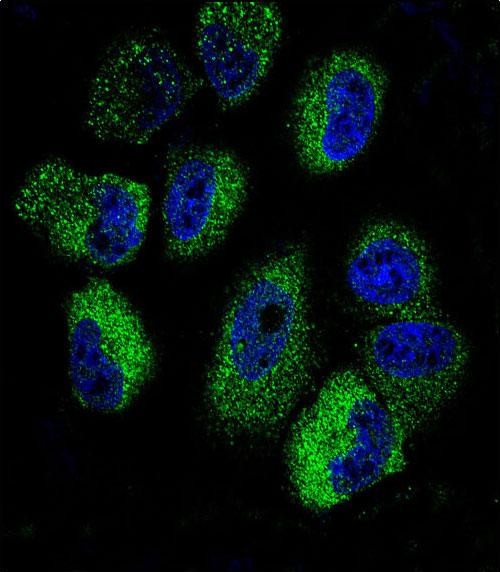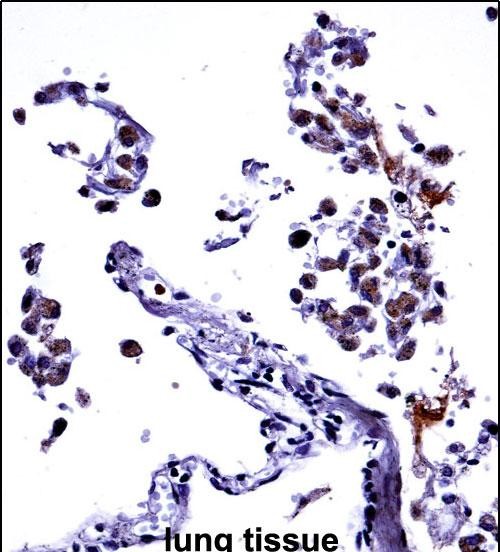


| WB | 1/1000 | Human,Mouse,Rat |
| IF | 咨询技术 | Human,Mouse,Rat |
| IHC | 1/100-1/500 | Human,Mouse,Rat |
| ICC | 1/10-1/50 | Human,Mouse,Rat |
| FCM | 咨询技术 | Human,Mouse,Rat |
| Elisa | 咨询技术 | Human,Mouse,Rat |
| Aliases | Interleukin-13, IL-13, IL13, NC30 |
| Entrez GeneID | 3596 |
| WB Predicted band size | 15.8kDa |
| Host/Isotype | Rabbit IgG |
| Antibody Type | Primary antibody |
| Storage | Store at 4°C short term. Aliquot and store at -20°C long term. Avoid freeze/thaw cycles. |
| Species Reactivity | Human |
| Immunogen | This IL13 antibody is generated from rabbits immunized with a KLH conjugated synthetic peptide between 118-146 amino acids from the C-terminal region of human IL13. |
| Formulation | Purified antibody in PBS with 0.05% sodium azide. |
+ +
以下是3篇关于IL-13抗体的代表性文献摘要:
---
1. **标题**:*Lebrikizumab Treatment in Adults with Asthma*
**作者**:Corren J, et al.
**摘要**:该临床试验(II期)评估抗IL-13单抗lebrikizumab对未控制哮喘患者的疗效。结果显示,治疗组患者肺功能(FEV1)显著改善,尤其在血液periostin水平高的亚组中效果更明显,表明IL-13靶向治疗具有生物标志物指导的潜力。
2. **标题**:*Tralokinumab for Severe Asthma: A Phase 2b Trial*
**作者**:Brightling CE, et al.
**摘要**:研究报道抗IL-13单抗tralokinumab在严重哮喘患者中的随机对照试验。尽管整体人群FEV1改善未达统计学显著性,但在高Th2表型(如嗜酸性粒细胞增多)患者中观察到症状减轻,提示IL-13通路在特定哮喘亚型中的作用。
3. **标题**:*IL-13 Antibodies Block Inflammation in Atopic Dermatitis*
**作者**:Guttman-Yassky E, et al.
**摘要**:探讨IL-13在中重度特应性皮炎(AD)中的致病机制,并验证抗IL-13抗体的治疗潜力。临床数据显示,IL-13抑制可显著降低皮肤炎症标志物(如TARC/CCL17),改善患者皮损评分,支持IL-13作为AD治疗的关键靶点。
4. **标题**:*Structural Basis of IL-13 Neutralization by Antibody Therapy*
**作者**:Smith DH, et al.
**摘要**:通过X射线晶体学解析IL-13蛋白与其单克隆抗体的复合物结构,揭示抗体通过结合IL-13的受体结合域阻断下游信号传导的分子机制,为优化抗体药物设计提供结构生物学依据。
---
以上文献涵盖临床研究(哮喘、皮肤病)、机制探索及结构解析,反映IL-13抗体在不同领域的应用与科学进展。
Interleukin-13 (IL-13) is a Th2 cytokine central to allergic inflammation and immune regulation. It binds to receptors IL-13Rα1 and IL-13Rα2. activating signaling pathways like JAK-STAT and MAPK, which drive inflammatory responses, tissue remodeling, and mucus overproduction. Dysregulated IL-13 signaling is implicated in asthma, atopic dermatitis, eosinophilic esophagitis, and other type 2 inflammatory diseases.
IL-13-targeting antibodies are designed to block this pathway, offering therapeutic potential. Early monoclonal antibodies (mAbs) focused on neutralizing IL-13 or its receptors. For example, lebrikizumab and tralokinumab bind IL-13. preventing receptor engagement, while duplimab targets IL-13Rα1. Despite mixed clinical outcomes in asthma, these agents showed efficacy in atopic dermatitis, leading to recent FDA approvals (e.g., lebrikizumab for moderate-to-severe atopic dermatitis in 2023). Challenges include patient heterogeneity and redundancy in Th2 pathways, as IL-4 shares receptors with IL-13. Next-generation approaches explore bispecific antibodies (e.g., targeting IL-4/IL-13) and combination therapies to improve efficacy. Research also investigates biomarkers (e.g., periostin) to predict treatment response. Overall, IL-13 antibodies represent a promising but evolving strategy for type 2 inflammation, with ongoing trials expanding their scope to fibrotic diseases and cancer.
×